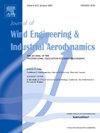Numerical investigation of the influence of street length and building configurations on ventilation and pollutant dispersion in idealized street canyons
IF 4.9
2区 工程技术
Q1 ENGINEERING, CIVIL
Journal of Wind Engineering and Industrial Aerodynamics
Pub Date : 2025-02-01
DOI:10.1016/j.jweia.2025.106016
引用次数: 0
Abstract
The paper investigates the influence of street length on ventilation and dispersion of traffic-induced pollutants in urban street canyons, an aspect often overlooked in previous studies. Employing computational fluid dynamics (CFD), the research explores airflow and pollutant dispersion in symmetric, step-up, and step-down canyons across different aspect ratios (AR = 1 and 3) and street lengths (L), ranging from 2 to 20 times the street width (W). The results indicate that pollutant concentration increases with street length in symmetric and step-up canyons, whereas it decreases in step-down canyons for L > 10W. High-rise (AR = 3) step-down canyons exhibit higher pollutant levels compared to their low-rise (AR = 1) counterparts, while step-up canyons exhibit the opposite trend. In symmetric canyons with L/W ≤ 5, low-rise configurations have nearly double the pollutant concentration of high-rise canyons, but this relationship reverses for L/W > 5. Ventilation is more effective at street ends than at the canyon roof, with turbulent velocity components dominating over mean velocity in driving air exchange. Higher L/W ratios correlate with reduced air exchange rates, signifying decreased ventilation efficiency as street length increases. These findings offer critical insights for enhancing urban air quality through optimized street canyon design.

理想街道峡谷中街道长度和建筑形态对通风和污染物扩散影响的数值研究
本文研究了街道长度对城市街道峡谷通风和交通污染物扩散的影响,这是以往研究中经常忽视的一个方面。采用计算流体力学(CFD)方法,研究了不同长宽比(AR = 1和3)和街道长度(L)(2 ~ 20倍街道宽度(W))下对称、升压和降压峡谷中的气流和污染物扩散情况。结果表明:对称和升压峡谷中污染物浓度随街道长度增加而增加,L >在降压峡谷中污染物浓度随街道长度减少;10 w。高层(AR = 3)降压峡谷的污染物水平高于低层(AR = 1)峡谷,而升压峡谷的趋势则相反。在L/W≤5的对称峡谷中,低层结构的污染物浓度几乎是高层结构的两倍,但L/W >则相反;5. 街道末端的通风比峡谷顶部更有效,湍流速度分量在驱动空气交换方面占主导地位。较高的L/W比率与空气交换率降低相关,这意味着随着街道长度的增加,通风效率降低。这些发现为通过优化街道峡谷设计来提高城市空气质量提供了重要的见解。
本文章由计算机程序翻译,如有差异,请以英文原文为准。
求助全文
约1分钟内获得全文
求助全文
来源期刊
CiteScore
8.90
自引率
22.90%
发文量
306
审稿时长
4.4 months
期刊介绍:
The objective of the journal is to provide a means for the publication and interchange of information, on an international basis, on all those aspects of wind engineering that are included in the activities of the International Association for Wind Engineering http://www.iawe.org/. These are: social and economic impact of wind effects; wind characteristics and structure, local wind environments, wind loads and structural response, diffusion, pollutant dispersion and matter transport, wind effects on building heat loss and ventilation, wind effects on transport systems, aerodynamic aspects of wind energy generation, and codification of wind effects.
Papers on these subjects describing full-scale measurements, wind-tunnel simulation studies, computational or theoretical methods are published, as well as papers dealing with the development of techniques and apparatus for wind engineering experiments.

 求助内容:
求助内容: 应助结果提醒方式:
应助结果提醒方式:


